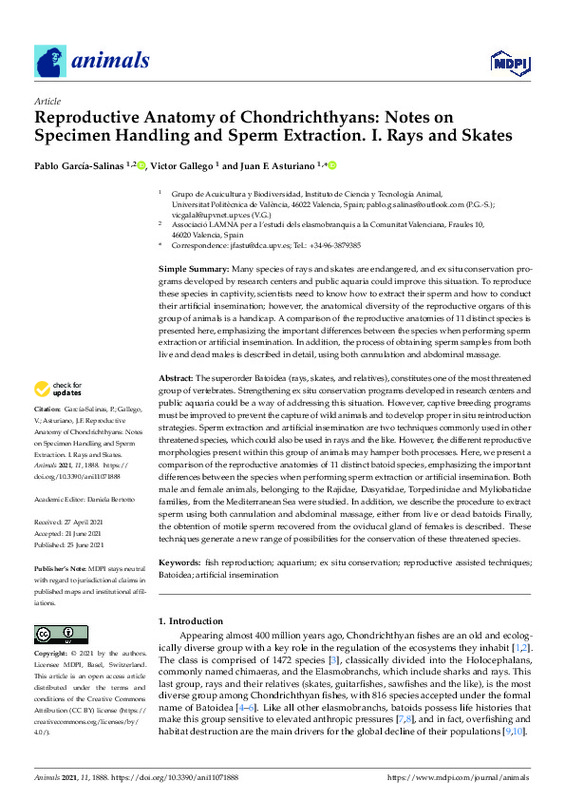JavaScript is disabled for your browser. Some features of this site may not work without it.
Buscar en RiuNet
Listar
Mi cuenta
Estadísticas
Ayuda RiuNet
Admin. UPV
Reproductive Anatomy of Chondrichthyans: Notes on Specimen Handling and Sperm Extraction. I. Rays and Skates
Mostrar el registro sencillo del ítem
Ficheros en el ítem
| dc.contributor.author | García-Salinas, Pablo
|
es_ES |
| dc.contributor.author | Gallego Albiach, Victor
|
es_ES |
| dc.contributor.author | Asturiano, Juan F.
|
es_ES |
| dc.date.accessioned | 2022-05-13T18:05:53Z | |
| dc.date.available | 2022-05-13T18:05:53Z | |
| dc.date.issued | 2021-07 | es_ES |
| dc.identifier.uri | http://hdl.handle.net/10251/182602 | |
| dc.description.abstract | [EN] Many species of rays and skates are endangered, and ex situ conservation programs developed by research centers and public aquaria could improve this situation. To reproduce these species in captivity, scientists need to know how to extract their sperm and how to conduct their artificial insemination; however, the anatomical diversity of the reproductive organs of this group of animals is a handicap. A comparison of the reproductive anatomies of 11 distinct species is presented here, emphasizing the important differences between the species when performing sperm extraction or artificial insemination. In addition, the process of obtaining sperm samples from both live and dead males is described in detail, using both cannulation and abdominal massage. The superorder Batoidea (rays, skates, and relatives), constitutes one of the most threatened group of vertebrates. Strengthening ex situ conservation programs developed in research centers and public aquaria could be a way of addressing this situation. However, captive breeding programs must be improved to prevent the capture of wild animals and to develop proper in situ reintroduction strategies. Sperm extraction and artificial insemination are two techniques commonly used in other threatened species, which could also be used in rays and the like. However, the different reproductive morphologies present within this group of animals may hamper both processes. Here, we present a comparison of the reproductive anatomies of 11 distinct batoid species, emphasizing the important differences between the species when performing sperm extraction or artificial insemination. Both male and female animals, belonging to the Rajidae, Dasyatidae, Torpedinidae and Myliobatidae families, from the Mediterranean Sea were studied. In addition, we describe the procedure to extract sperm using both cannulation and abdominal massage, either from live or dead batoids Finally, the obtention of motile sperm recovered from the oviducal gland of females is described. These techniques generate a new range of possibilities for the conservation of these threatened species. | es_ES |
| dc.description.sponsorship | This research was partially funded by the Fundacion Biodiversidad (PRCV00683). PGS has a PhD contract from the European Union through the Operational Program of the European Social Fund (ESF) of the Comunitat Valenciana 2014-2020 ACIF 2018 (ACIF/2018/147). VG has a postdoc contract from the MICIU, Programa Juan de la Cierva-Incorporacion (IJCI-2017-34200). | es_ES |
| dc.language | Inglés | es_ES |
| dc.publisher | MDPI AG | es_ES |
| dc.relation.ispartof | Animals | es_ES |
| dc.rights | Reconocimiento (by) | es_ES |
| dc.subject | Fish reproduction | es_ES |
| dc.subject | Aquarium | es_ES |
| dc.subject | Ex situ conservation | es_ES |
| dc.subject | Reproductive assisted techniques | es_ES |
| dc.subject | Batoidea | es_ES |
| dc.subject | Artificial insemination | es_ES |
| dc.subject.classification | PRODUCCION ANIMAL | es_ES |
| dc.title | Reproductive Anatomy of Chondrichthyans: Notes on Specimen Handling and Sperm Extraction. I. Rays and Skates | es_ES |
| dc.type | Artículo | es_ES |
| dc.identifier.doi | 10.3390/ani11071888 | es_ES |
| dc.relation.projectID | info:eu-repo/grantAgreement/GVA//ACIF%2F2018%2F147/ | es_ES |
| dc.relation.projectID | info:eu-repo/grantAgreement/Fundación Biodiversidad//PRCV00683/ | es_ES |
| dc.relation.projectID | info:eu-repo/grantAgreement/MCIU//IJCI-2017-34200//Ayuda Juan de la Cierva Incorporación - Gallego Albiach/ | es_ES |
| dc.rights.accessRights | Abierto | es_ES |
| dc.contributor.affiliation | Universitat Politècnica de València. Departamento de Ciencia Animal - Departament de Ciència Animal | es_ES |
| dc.description.bibliographicCitation | García-Salinas, P.; Gallego Albiach, V.; Asturiano, JF. (2021). Reproductive Anatomy of Chondrichthyans: Notes on Specimen Handling and Sperm Extraction. I. Rays and Skates. Animals. 11(7):1-16. https://doi.org/10.3390/ani11071888 | es_ES |
| dc.description.accrualMethod | S | es_ES |
| dc.relation.publisherversion | https://doi.org/10.3390/ani11071888 | es_ES |
| dc.description.upvformatpinicio | 1 | es_ES |
| dc.description.upvformatpfin | 16 | es_ES |
| dc.type.version | info:eu-repo/semantics/publishedVersion | es_ES |
| dc.description.volume | 11 | es_ES |
| dc.description.issue | 7 | es_ES |
| dc.identifier.eissn | 2076-2615 | es_ES |
| dc.identifier.pmid | 34202036 | es_ES |
| dc.identifier.pmcid | PMC8300314 | es_ES |
| dc.relation.pasarela | S\444278 | es_ES |
| dc.contributor.funder | European Social Fund | es_ES |
| dc.contributor.funder | Generalitat Valenciana | es_ES |
| dc.contributor.funder | FUNDACION BIODIVERSIDAD | es_ES |
| dc.contributor.funder | Fundación Biodiversidad | es_ES |
| dc.contributor.funder | Ministerio de Ciencia, Innovación y Universidades | es_ES |
| dc.subject.ods | 14.- Conservar y utilizar de forma sostenible los océanos, mares y recursos marinos para lograr el desarrollo sostenible | es_ES |
| upv.costeAPC | 1800 | es_ES |








